
We were all artists when we were kids. It’s just that our avenue of self-expression was often the walls of our homes where the displeased faces of our family members were what we had for a response. It’s only when one gets older does one realize that the ambition of making walls into canvases carries much more responsibility and aspiration. Some of us forgot about our childhood “talents” while others stuck to creating the city they dreamt about.
Փոքր տարիքում բոլորս էլ սթրիթ արտիստներ էինք, պարզապես ինքնարտահայտման փողոցը տան պատերն էին, իսկ լսարանը՝ ընտանիքի անդամների դժգոհ դեմքերը։ Արդեն գիտակից տարիքում հասկացանք, որ փողոցը կտավ դարձնելու մեր մեծ ձգտումն իրականում ավելի բարդ ու պատասխանատու ընթացք է։ Մեզնից ոմանք մոռացան իրենց նկարչական «տաղանդները», մյուսները զարգացրին դրանք՝ ստեղծելով իրենց պատկերացրած Երևանը։
What is Your Yerevan Like ?
Our perceptions of Yerevan are not that different - it is the center of urban life where people run to get to their jobs, freelancers make their way to their cups of coffee at Achajour,* where there is a constant traffic jam on the road to the zoo and endless arguments in public transport about opening or closing windows.
Half-way through the work day, I dream about a tropical country where I’m drinking cocktails and not doing much else. Would that not be something? I could write an article sitting in Ecuador surrounded by tall palm trees and colorful streets. And one day, as I was walking thinking of nothing in the morning, I got a glimpse of tropical Yerevan on the wall of Tapastan.* You too may have seen the new and unique murals in downtown Yerevan with a distinguishable hand, these are called Yerevantropics by Sergey Navasardyan, who this morning transported me to another Yerevan. Sergey is a designer and he too started with the walls in his house and then moved on to draw on every available wall in his courtyard. Then he learned more about street art in other countries, the message and the purpose of it and decided to make it a thing in Yerevan as well. For the longest time, figuring out what his own message should be was a source of stress. In 2013, on one of the streets in Yerevan, he drew a pig with the writing, “Until another independence.” The aggression of that year’s events had manifested in the form of a pig, a protest against Russification and the Post-Soviet chronicle.
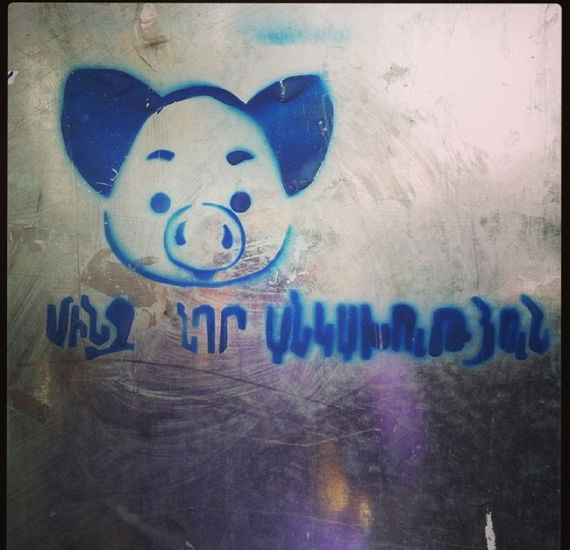
“Until another independence.”
Sergey says that when your street art reaches a certain scale you come to realize that you need to genuinely take care of the already violated urban landscape; that the piece you draw should not be just images on an empty wall, like the paintings in the archways of the city. “When you are interfering with the environment, it is important that you take that environment into consideration, to study, understand it. It is like a tattoo, it is important to have the right image in the right place,” Sergey explains “It’s a pity that you understand this later on. But better late but skilled, it gives you the chance to cover the old with the new, to edit or just go and cover it in a smooth layer of paint, make it disappear.”
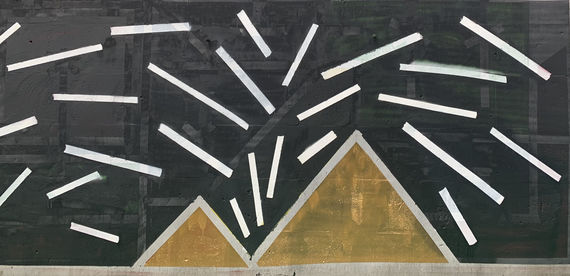
Street art has been a means of protest, be it against the authorities or the injustices of the time. You can even sometimes consider it to be a media outlet of sorts which allows for the citizen, the artist to express dissatisfaction and quench the need to be heard.
“Ararat with palm trees has a satirical twist. Do you remember, there was a time when every every drawing of Mount Ararat would have two aspen trees? For me, Yerevan is a city of utopic thoughts and I decided that palm trees should come to replace the aspen trees. I draw Mt. Ararat but it is not ours, we do not have palm trees either. Overall, my work is about the city I would have liked to see. Imagine if there were palm trees in Yerevan, then the sea would probably be somewhere not so far from Charbahk*.”
Sergey says we have a tendency to live by old and nostalgic thoughts, a longing for things and events that have not happened or are not ours. Talking to Sergey, a word that I had come across about a year ago kept coming to mind - Hiraeth- homesickness for a home that you can never return to, no longer exists, or maybe never was.
It is interesting that the lines of legal and illegal street art in Armenia are unclear. The law says that vandalizing buildings or other structures with obscene writing or images, harming property in public transport or in other public places, is punishable with a fine in the amount of 50 to 100 times the minimal salary of the perpetrator if the defendant has no prior police record, or with up to two months imprisonment. In practice, if the work does not have political context, is not about social issues, it will likely be preserved, even though that does not make it legal. One could assume the authorities and the police are quite the connoisseurs and decide to keep the ones that are “pretty” and “nice.”
For Sergey, street art is fine arts without the canvas and the studio, he paints on the streets. He says his art is public and he wants Yerevan to be the way he dreams of it.
A little astray from the center and yet part of the center of Yerevan, at Kond, the mood is already tropical. Sergey has managed to leave his mark there as well. He says Kond is like an open air studio with interesting people who have interesting lives and stories.
“My first work in Kond, one that I really liked was painted over and I went to find out why they covered it up. They were not in a friendly mood but after I explained what I had painted and why, I painted a second mural next to where the first was and then the third, the fourth. I wanted to change the atmosphere and the mood in Kond and I accomplished that. The people in Kond helped. Now I can go paint there during the day instead of working at night.”
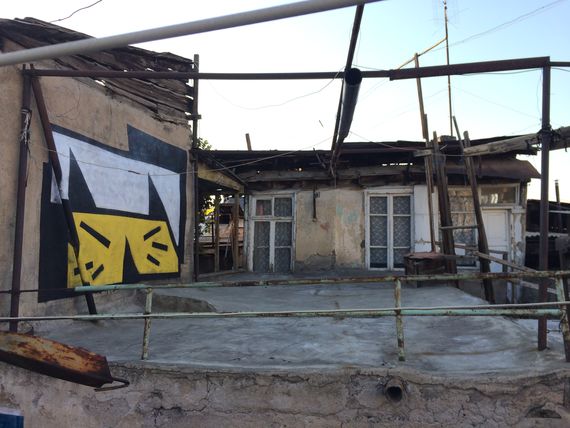
It is difficult to imagine palm trees and colors in the overlooked neighborhood but turns out it was in Kond that Yerevantropics was able to create a separate republic with unique street art and its own mood. A street artist from Georgia has already worked in Kond and there are plans to invite artists from other countries for a collaboration next season. And this despite the constant plans to demolish the neighborhood, “Why make urban art in Kond and why specifically in the area that looks set for demolition? And why not? if they are going to tear it down one way or another, then we better make the best use of it until that day comes. Especially since the people there have welcomed it.”
Kond, one of the oldest surviving neighborhoods in the city looks set to become the proof of the existence of street art in Yerevan. A stage that will have its curtains open as long as Kond survives in its current form. And if there is anyone from Kond reading this, thank you for providing the inspiration on behalf of myself and Sergey.
* Achajur & Tapastan - Cafes in Yerevan
*Charbakh - A suburb of Yerevan
Photos courtesy of the artist.
Ինչպիսի՞ Երևանում ես ապրում դու։
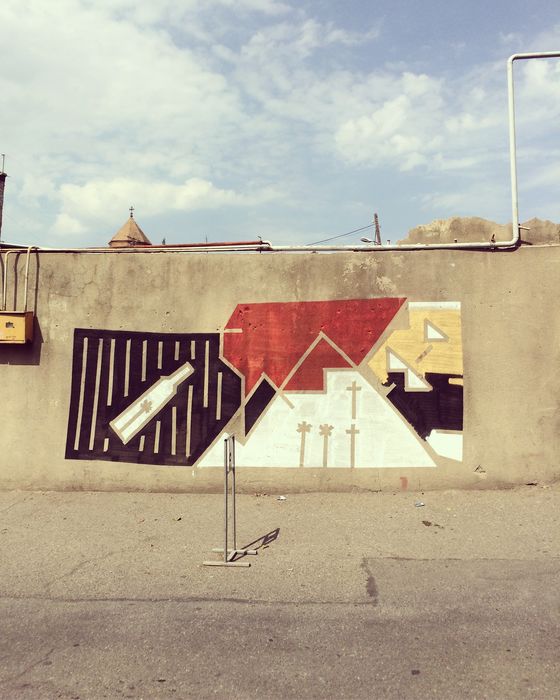
Երևանի մասին մեր պատկերացումները շատ տարբեր չեն. քաղաքային կյանքի կենտրոնում մարդիկ վազում են աշխատանքի, ֆրիլանսերները՝ Աչաջուր, գազանանոցի մոտ հավերժ խցանումներ են ու երթուղայինում հավերժ պայքար՝ պատուհանը բացելու ու փակելու համար։ Աշխատանքային օրվա կեսին երազում ես հայտնվել արևադարձային որևէ երկրում, կոկտեյլ խմել ու ոչ մի բան չանել։ Հա, ի՞նչ վատ կլիներ, հոդվածս կգրեի Էկվադորից, շուրջս մեծ արմավենիներ կլինեին ու գունավոր փողոցներ։ Այս առավոտ քայլում էի ու մտածում ոչմիբանի մասին ու «Տափաստանի» պատին արևադարձային Երևան կար: Հաստատ գիտեմ, Կենտրոնի պատերին տեսել եք այս նոր ու յուրահատուկ պատկերները, որոնք հստակ ձեռագիր ունեն. դրանք Yerevantropics-ինն են։ Սերգեյ Նավասարդյանն այս առավոտ տվեց հնարավորությունը լինելու արևադարձային Երևանում։
Սերգեյը մասնագիտությամբ դիզայներ է ու պատմում է, որ ինքն էլ է սկզբում նկարել տան ու իրենց բակի հնարավոր բոլոր պատերին։ Ուսումնասիրելուց հետո փողոցային արվեստի ուղերձն ու նպատակները Հայաստանից դուրս, հասկացել է՝ ուզում է զարգացնել սթրիթ-արտը Երևանում։ Երկար ժամանակ, սեփական ուղերձի շուրջ մտորելիս, սթենսիլներ էր անում։ 2013 թվականին, օրինակ, Կենտրոնի փողոցներից մեկում Խոզ էր նկարել՝ «մինչ նոր անկախություն» գրությամբ։ Այդ տարիների զայրույթն արտահայտվել էր Խոզի կերպարանքով, ուղղված ռուսականության ու հետխորհրդային հետընթացի դեմ։

Սերգեյն ասում է, որ ավելի մեծ մասշտաբի սթրիթ-արտով զբաղվելիս հասկանում ես՝ պետք է հոգ տանել առանց այն էլ բռնաբարված քաղաքային միջավայրի մասին, քո նկարած կտորները չպետք է զուտ դատարկ, պատի նկարներ լինեն, ինչպես այսօր երևանյան դալաններում է։ «Կարևոր ա միջավայրը փոխելուց հաշվի առնել այն, հասկանալ, ուսումնասիրել. դրանք նման են դաջվածքների, պետք է ճիշտ վայրում ճիշտ նկար պատկերել։ Ափսոս, այդ փաստը ուշ ես հասկանում, բայց լավ է ուշ և փորձառու. սա հնարավորություն ա տալիս փակել նախորդը նորովի, խմբագրել, կամ գնալ ու ներկել հարթ, որ կորի»։
Փողոցային արվեստը իշխանությունների, անարդարության դեմ դժգոհությունն արտահայտելու ձև է։ Դրա միջոցով քաղաքացին, արվեստագետն արտահայտում է իր բողոքը, բավարարում իր՝ լսված լինելու կարիքը։ «Արարատը՝ պալմաներով, ունի հումորային կոնտեքստ։ Կարող ա՞ հիշես, որ մի ժամանակ Արարատը որ նկարում էին, իրա դեմը կային երկու հատ բարդի։ Երևանը իմ համար ուտոպիստական մտքերի քաղաք ա ու որոշեցի որ էդ երկու հատ բարդին պիտի փոխվի երկու հատ պալմայով։ Ես նկարում եմ Արարատը, բայց փաստացի ինքը մերը չի ու մենք չունենք պալմաներ։ Իմ աշխատանքները մեծ հաշվով իմ երազանքի Երևանի մասին, էնպիսին, ինչպիսին ես կուզեի տեսել Երևանը։ Պատկերացնո՞ւմ ես, եթե մենք ապրեինք պալմաներով քաղաքում, ենթադրաբար Չարբախից մի քիչ էն կողմ ծով պետք ա լիներ»։ Սերգեյը նշում է, որ մենք ունենք հին ու նոստալգիկ մտքերով ապրելու հակում ու կարոտ՝ դեպի իրերն ու իրադարձությունները, որոնք փաստացի չկան կամ մերը չեն։ Նրա հետ զրուցելիս անընդհատ մի բառ էր պտտվում գլխումս, որի մասին ինձ մի տարի առաջ էին պատմել. HIRAETH- Կարոտ տան հանդեպ ուր երբեք չես կարող վերադառնալ, որը այլեւս գոյություն չունի կամ գուցե երբեք չի եղել:
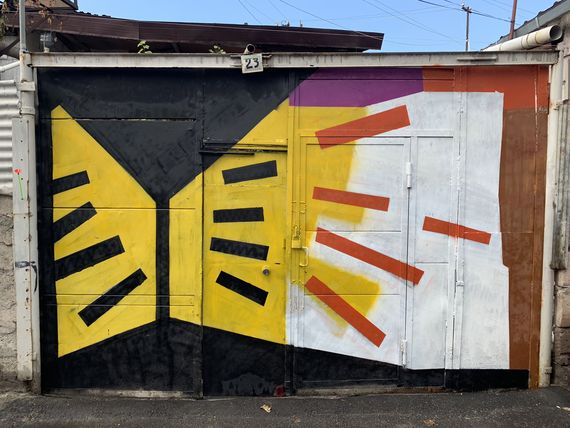
Երևանում սթրիթ-արտի իլեգալ և լեգալ դրսևորումները միանշանակ չեն։ Եթե աշխատանքը քաղաքական ենթատեքստ չունի, չի բարձրաձայնում սոցիալական խնդիրներ, ամենայն հավանականությամբ պահպանվում է. բայց դա այն լեգալ չի դարձնում։ Ստացվում է, որ իշխանություններն ու ոստիկաններն ավելի էսթետ են ու պահպանում են արվեստի գործեր, որոնք «գեղեցիկ» են ու «պուպուշ»։
Այս դեպքում բախվում ենք հստակ կողմնապահության, երբ իշխանությունն է որոշում է, թե որ արվեստի գործը պիտի ապրի փողոցում, որը՝ ոչ։
ՀՀ քրեական օրենսգրքի 260-րդ հոդվածը սահմանում է. «Շենքերը կամ այլ կառույցներն անպարկեշտ գրագրություններով կամ պատկերներով պղծելը, հասարակական տրանսպորտում կամ այլ հասարակական վայրերում գույքը վնասելը, եթե բացակայում են առավել ծանր հանցագործության հատկանիշները՝ պատժվում են տուգանքով՝ նվազագույն աշխատավարձի հիսնապատիկից հարյուրապատիկի չափով, կամ կալանքով՝ առավելագույնը երկու ամիս ժամկետով»:
Սերգեյի համար սթրիթ-արտը նկարչություն է․ նա չունի կտավ, չունի արվեստանոց, նկարում է փողոցում։ Նրա համար իր արվեստը հանրային չէ։
Կենտրոնից դուրս, բայց Կենտրոնին շատ մոտ Կոնդում արդեն արևադարձային տրամադրություն է։ Սերգեյը Կոնդում էլ է հասցրել թողնել իր հետքը։ Նրա համար Կոնդը ասես բաց արվեստանոց լինի՝ հետաքրքիր մարդկանցով, հետաքրքիր կենցաղով ու պատմություններով։ «Առաջին գործս Կոնդում, որ դուրս շատ էր գալիս, փակեցին, գնացի իմանամ խի են փակել։ Ընկերական չէին տրամադրված, հետո որ բացատրեցի ինչ եմ նկարել ու ինչի, նկարեցի երկրորդը անմիջապես ջնջվածի կողքը, ու անցա երրորդին, չորրորդին։ Ուզում էի Կոնդում միջավայր ու տրամադրություն փոխել, ստացվեց: Կոնդեցիք էլ օգնեցին: Արդեն գիշերվա փոխարեն գնում ու ցերեկն էի նկարում»։
Կոնդում դժվար է պատկերացնել արմավենիներ ու գույներ, բայց պարզվում է Yerevantropics-ը հենց Կոնդում ստեղծեց իր առանձին հանրապետությունը՝ յուրօրինակ սթրիթ-արտով ու տրամադրությամբ։ Սերգեյը մտադիր է այլ արտիստների էլ հրավիրել, որպեսզի ստեղծվի հենց այն տրամադրությունը, որի մասին ինքն է երազում։
Կոնդը քանդելու մասին անվերջ խոսակցությունները Սերգեյի համար չեն։ Եվ եթե քանդելու են, ինչո՞ւ տարածությունն ավելի լավ չօգտագործել, մանավանդ, որ կոնդեցիներն էլ դեմ չեն։ «Ինչո՞ւ ուրբան-արտ Կոնդում, կամ ավելի ճիշտ Կոնդի էն հատվածում, որը կարծես թե սենց թե նենց քանդելու են։ Իսկ ինչո՞ւ ոչ։ Եթե սենց թե նենց քանդելու են, կարելի է տարածությունն ավելի օպտիմալ օգտագործել՝ մինչ սպասում ենք քանդելուն։ Հատկապես, տեղացիք շատ ջերմ ընդունեցին»։
Կոնդում, Սերգեյից բացի, վրացի մի արտիստ էլ է աշխատել, ծրագրեր կան համագործակցելու օտարերկրացիների հետ։ Անփոփոխ ու անշարժ շրջապատին նոր շունչ հաղորդած Yerevantropics-ը վստահ է, որ Կոնդում ստեղծվելու է նոր, հետաքրքիր ու գունավոր միջավայր, որը լինելու է Հայաստանի սթրիթ-արտի գոյության ապացույց, որը կապրի հավանաբար այնքան, որքան Կոնդը՝ այսօրվա տեսքով։ Ու եթե կոնդեցիներ են կարդում՝ «ձեզ լիքը մերսի իմ ու հատկապես Սերգեյի կողմից՝ նրան ոգեշնչելու համար»։
Yerevantropics-ը ցույց է տալիս, որ Հայաստանում urban art կա ու այն զարգանալու է։ Դե, Կենտրոնով ու հատկապես Կոնդով անցնելիս ուշադիր եղեք պատերին, ես էլ գնամ Էկվադորում կոկտեյլս խմելու։
related
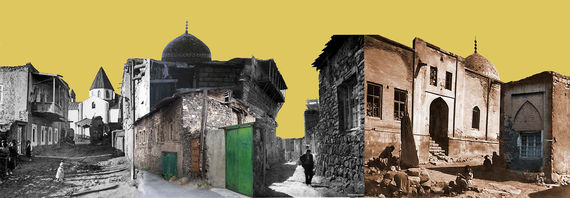
Kond: A City Within a City
A tucked away city within a city, the district of Kond in Yerevan has a rich history and a promising future only if authorities undertake a large-scale restoration. What are the stories of Kond and what does the future hold for one of the oldest quarters in the country’s capital?



